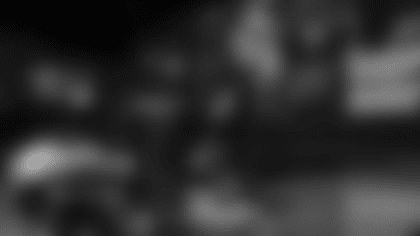Tommy McDonald was my first sports idol. Actually, he was the only one. I had other favorite players on other teams but Tommy was my hero.
I kept a scrapbook with all the stories written about him and there were many. When they put him on the cover of Sports Illustrated with the caption "Football's Best Hands," I hung it in my bedroom. I had a program he signed for me one day at Franklin Field.
But mostly I had the memories ...
The memories of him making acrobatic catches, the memories of him bouncing up after a big hit, the memories of him tumbling into a snowbank after scoring the go-ahead touchdown in the 1960 NFL Championship Game, the memories of the gutsy little receiver who played the game with no fear and no facemask, the daredevil who made the big play every week.
The memory I'll cherish though is that of meeting him at Eagles Training Camp in Hershey. He was a rookie third-round draft pick and I was a wide-eyed 10-year-old with an autograph book. I was waiting for him outside the locker room one August morning. I called him "Mr. McDonald." He said, "My name's Tommy."
That's how we met.
I asked for his autograph. He asked if I wanted to carry his helmet and we walked together to the practice field. It became a ritual. Every summer my family would go to Hershey to watch the Eagles practice. Every day I'd wait for Tommy at the locker room door. Over time he started calling me "Little Brother."
Even then I devoured football statistics. I knew everything about Tommy's career at the University of Oklahoma. I knew he never lost a game in three seasons. I knew he set dozens of school records and I knew he won the Maxwell Club Award as college player of the year. I told him he should have won the Heisman Trophy, but it went to Paul Hornung. He laughed.
"Yeah, Paul Hornung, the golden boy," he said.
In his seven seasons with the Eagles, we took a lot of walks together. I asked him a million questions. He answered every one with a patient smile. I remember asking him why he never wore a face mask. "Everyone else does," I said.
"Suppose I score a touchdown and a cheerleader wants to run up and give me a kiss," he said. "A face mask would just get in the way."
"Oh," I said fully believing him.
He laughed and said, "I'm only kidding." He explained he never wore a face mask in high school or college and when he tried it in the NFL he felt it blocked his vision so he took it off. Players were allowed to do that back in the day.
That was how I fell in love with pro football - spending those summers in Hershey then going to games on Sunday at Franklin Field. All the people who sat around us in Section EE knew about Tommy and me. Whenever he made a big catch - which was pretty much all the time - the men would turn to me, point, and smile.
"That's your boy," they would say.
I cried when Joe Kuharich traded Tommy to Dallas in March 1964. I was 17 so I thought I was way past shedding tears but I did that morning. The Eagles had traded my favorite player, a guy who had become like part of my family, and I had no say in it. The fan inside me probably died that day. It was the first time I knew - really knew - pro football was really just a business after all.
When I became a sports writer, I met Tommy at various functions. I interviewed him about the 1960 season and other moments in Eagles history. I never told him about the summers in Hershey. I didn't want to seem like some dopey fanboy. Also, there was a part of me that was afraid he wouldn't remember.
When we talked about his career - which spanned 12 remarkable seasons with five different teams - he would often say the one thing missing was a place in the Pro Football Hall of Fame. It bothered him that he was passed over - he wasn't even a finalist for the first 16 years he was eligible - and he had just about given up on ever getting elected.
So when I became a Hall of Fame voter, I began a campaign to get Tommy into the Hall of Fame. It should not have been hard. When he retired, he ranked sixth all time in NFL receptions, fourth in yards, and second in touchdowns. It took longer than it should have but finally in 1998 Tommy was voted into the Hall. What I didn't expect was for him to ask me to be his presenter in Canton.
Standing backstage at the Hall of Fame, I finally told Tommy about our history. I didn't know quite how to put it so I stumbled around saying, "I was your biggest fan," and "I used to wait for you outside the locker room." Suddenly, his eyes lit up.
"You were that kid," he said.
I didn't think he would remember but he did. He gave me a hug.
"I always wondered what happened to you," he said.
"Well, here I am," I replied.
Of all my experiences in sports, nothing comes close to the feeling of riding through the streets of Canton in an open convertible seated next to my boyhood idol. What are the odds of that happening for anyone? Who could ever be that lucky? Yet, it happened for me.
That was what inspired me to write the play, Tommy and Me, which was performed by Theatre Exile the past three summers. Tommy gave me so much in terms of his friendship when I was a boy and years later I was in position to give him something back, something he really wanted, and that was election to the Hall of Fame. It was more than a football story, it was a story of two lives coming full circle. Most of all, it was a story of dreams coming true.
I visited Tommy last month and we spent one more afternoon together. His daughter dressed him in his green No. 25 jersey and that's how I'll always remember him, in his Eagles jersey, smiling and giving me the thumbs-up sign.
Vince Lombardi once said: "If I had 11 Tommy McDonalds, I'd win a championship every year."
I'm sure Lombardi believed that. I believe it, too.
An award-winning writer and producer, Ray Didinger was inducted into the Pro Football Hall of Fame in 1995. He has also won six Emmy Awards for his work as a writer and producer at NFL Films. The five-time Pennsylvania Sportswriter of the Year is a writer and analyst for NBC Sports Philadelphia. Didinger will provide Eagles fans a unique historical perspective on the team throughout the year for PhiladelphiaEagles.com. You can read all of hisEagles History columns here.He is also the author ofThe Eagles Encyclopedia: Champions Edition which comes out in October.














